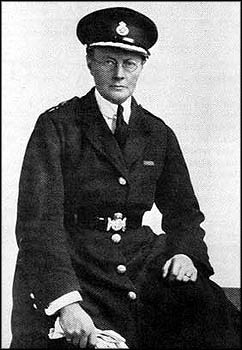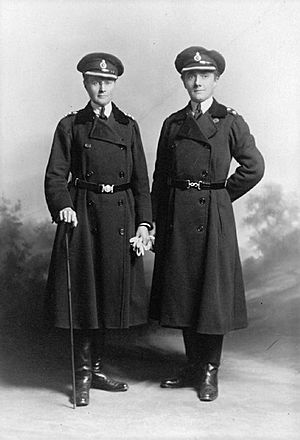Women's Police Service facts for kids
The Women's Police Service (WPS) was a group of women police officers in the United Kingdom. It was a volunteer group that worked from 1914 until 1940. This was the first time women wore police uniforms in the UK. The WPS helped people see that women could do important police work.
Contents
Starting the Women Police Volunteers
Before World War I, some people wanted women to become police officers. But the war stopped these plans. In 1914, two women named Nina Boyle and Margaret Damer Dawson met. They both saw how much trouble Belgian and French refugees were having in London.
Boyle and Damer Dawson asked Sir Edward Henry, who was the main police chief in London, for permission. They wanted to start the Women Police Volunteers (WPV). This group would train women to patrol London as volunteers. Their job was to offer help and advice to women and children. Nina Boyle led the group, with Margaret Damer Dawson as her helper. These volunteer women were allowed to patrol the streets of London. They helped women in need, and male police officers were asked to assist them. Nina Boyle was one of the first women to wear a police uniform.
Different Ideas for the WPV
Nina Boyle believed the WPV was a chance for women to help catch criminals. She also wanted women to have a bigger role in law enforcement. She saw the WPV as a way to support women. However, Margaret Damer Dawson was more focused on making sure people followed public rules. The government agreed with Dawson's view. So, the WPV's job mostly became about making sure people followed rules and watching over female workers, like those in factories. While this part of their work was approved, Boyle worried. She felt her group was being used to control women's freedom.
In February 1915, Boyle and Damer Dawson disagreed. This happened when the WPV was asked to enforce rules about where women could be near an army base in Grantham. Boyle did not agree with these rules. She also spoke out against similar rules in Cardiff. These rules limited where certain women could go at night. Margaret Damer Dawson, however, took a more practical approach. Most of the WPV members supported Dawson. Boyle asked Dawson to resign, but Dawson held a meeting. Almost all 50 policewomen at the meeting chose to follow Dawson.
The Women's Police Service Begins
After the disagreement, Dawson changed the group's name to the Women Police Service (WPS). She chose Mary Sophia Allen as her second-in-command. She also ended all ties with Nina Boyle's former group.
Even though another WPV group continued in Brighton, Dawson's new WPS became much more successful. WPS members searched women who worked in Ministry of Munitions factories. In August 1915, in Grantham, Edith Smith from the WPS became the first woman police constable in England. She had full power to arrest people. The WPS also started a home for babies in Kent. After Dawson passed away, it was renamed the "Damer Dawson Memorial Home for Babies."
Changes After the War
The WPV and WPS were the first groups to have women in police uniforms. They helped the government and the public get used to women doing police work. Later, in 1918-1919, a different group called the Voluntary Women Patrols helped create Britain's first official women's police force. This new force was called the Metropolitan Police Women Patrols. The first women in this official force came from the Voluntary Women Patrols. Their senior officer, Sofia Stanley, also came from that group. Later, some former WPS volunteers joined too. Damer Dawson wanted all WPS volunteers to become official police officers. But the police chief said no. He thought the WPS women were too well-educated and it might cause problems.
The WPS kept going even after women joined police forces like the Metropolitan Police in 1919. After Damer Dawson died in May 1920, Mary Allen took over. This led to some problems. In 1921, the Metropolitan Police Commissioner took Allen and four other senior WPS women to court. He said their uniforms looked too much like the official police uniforms. They had to pay a small fine. The group then changed its name to the Women's Auxiliary Service (WAS). They also changed their cap badge and added red shoulder straps. In 1920, WPS members had been sent to Ireland to help the police there. Allen also started focusing on international work. For example, she visited the British Army of the Rhine in 1923 to advise on using women police.
The End of the Service
In 1938, a new group called the Women's Voluntary Services for Civil Defence was set up. The WAS was invited to be part of its advisory council. Allen worked in this role until January 1940. It is not clear exactly when the WAS stopped existing. But it seems to have ended by 1940. In June 1940, a government official said it was "extremely doubtful" if the group still existed. After the 1940s, the name 'Women's Auxiliary Services' was used for other women's groups in the armed forces, not for Allen's organization.



